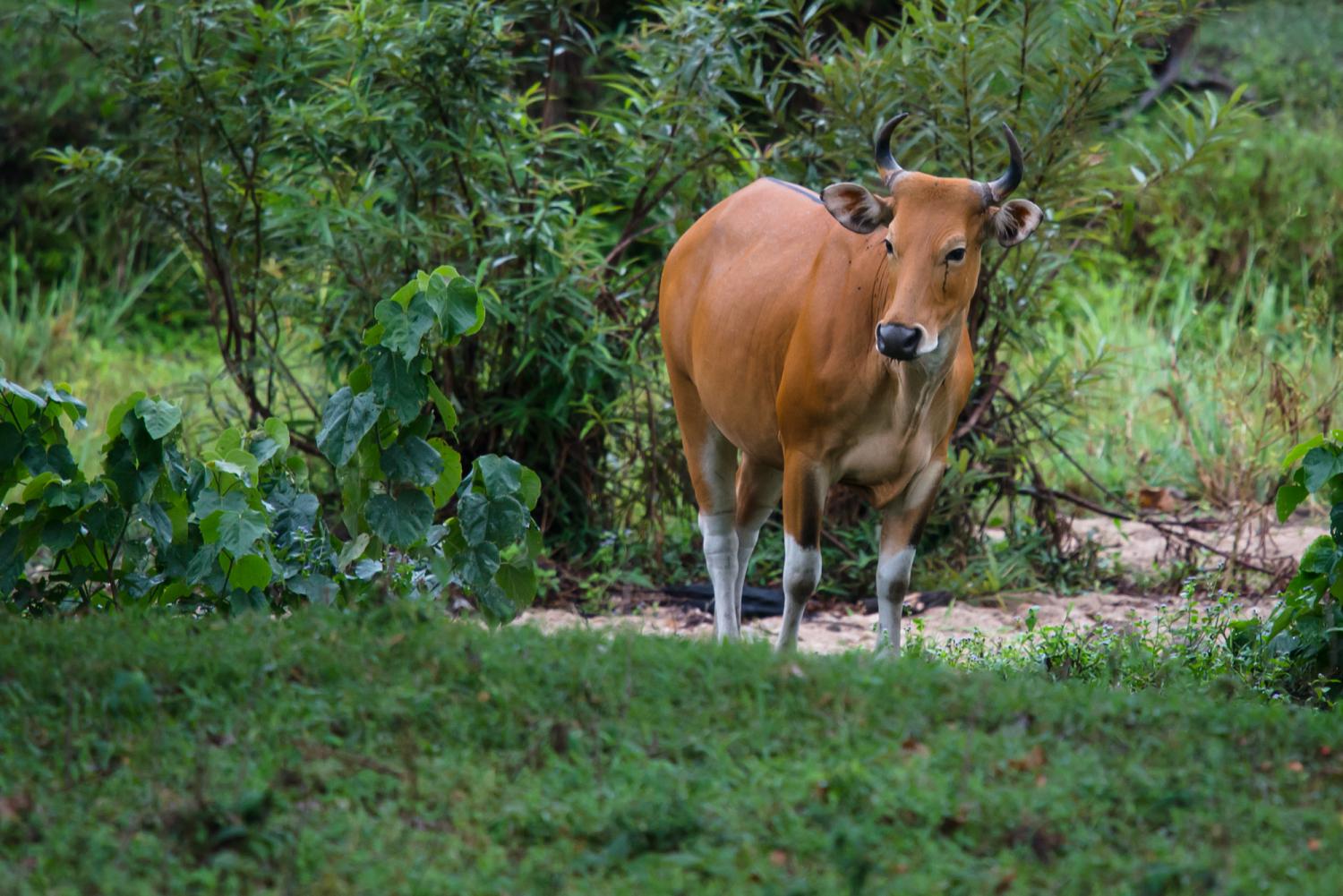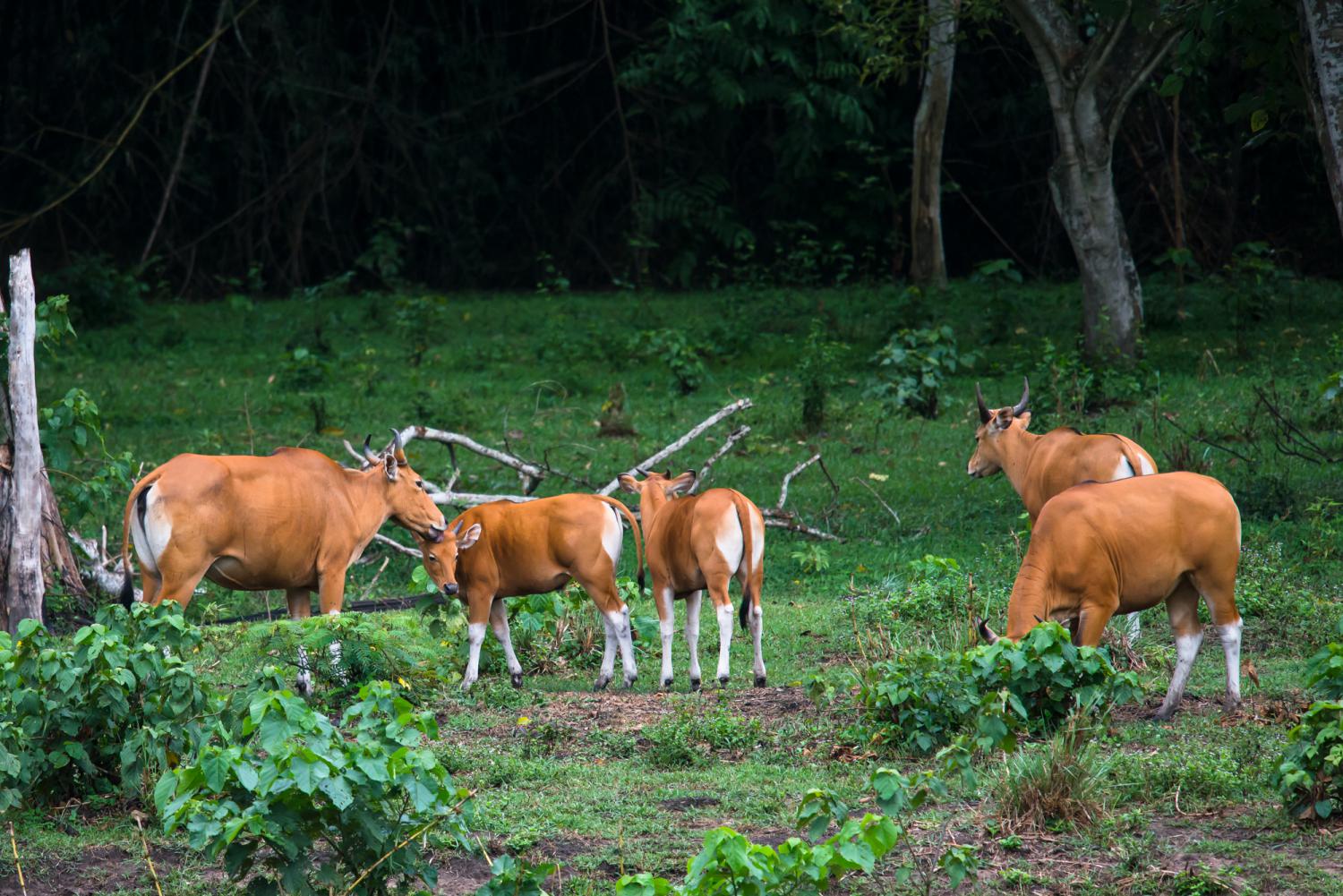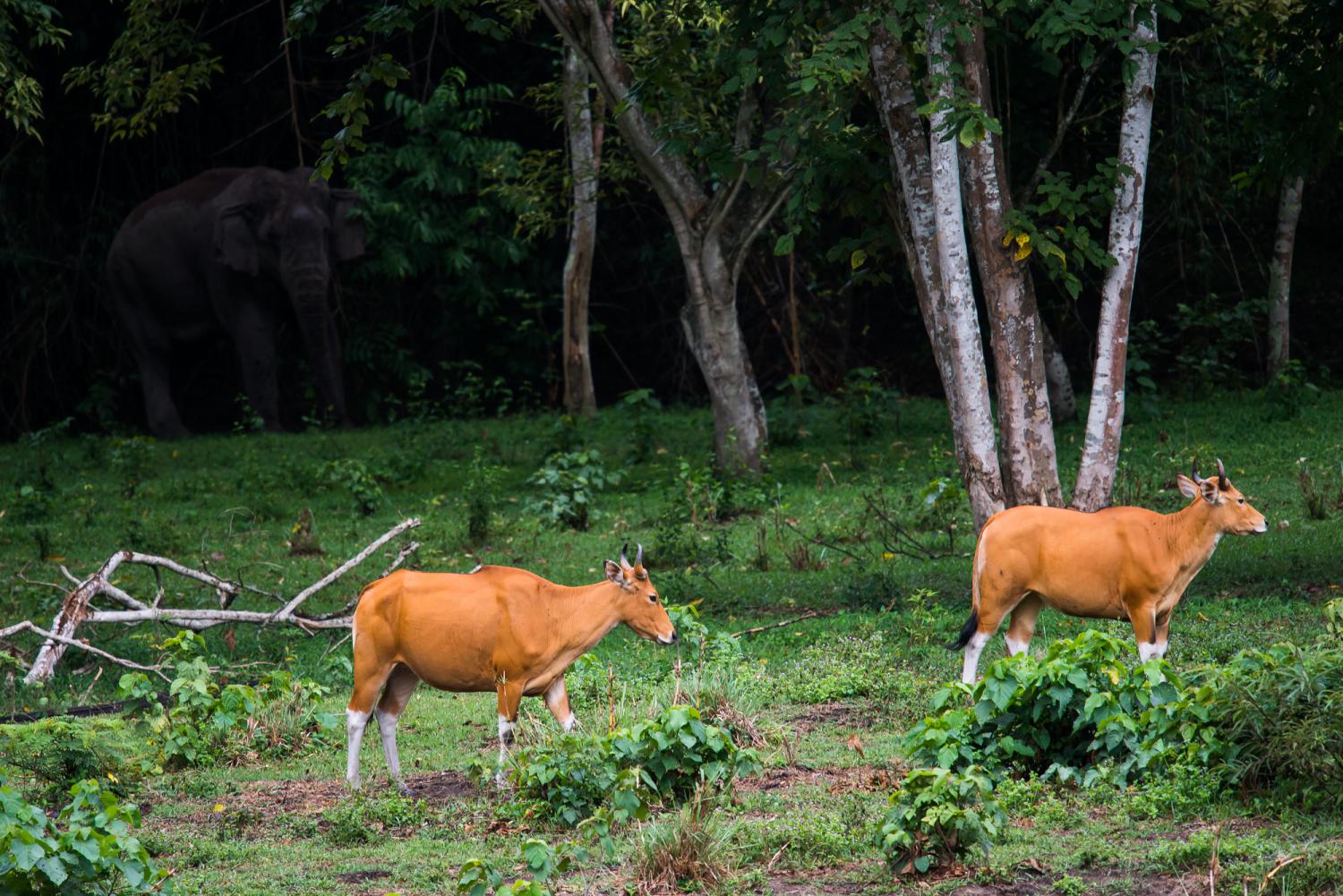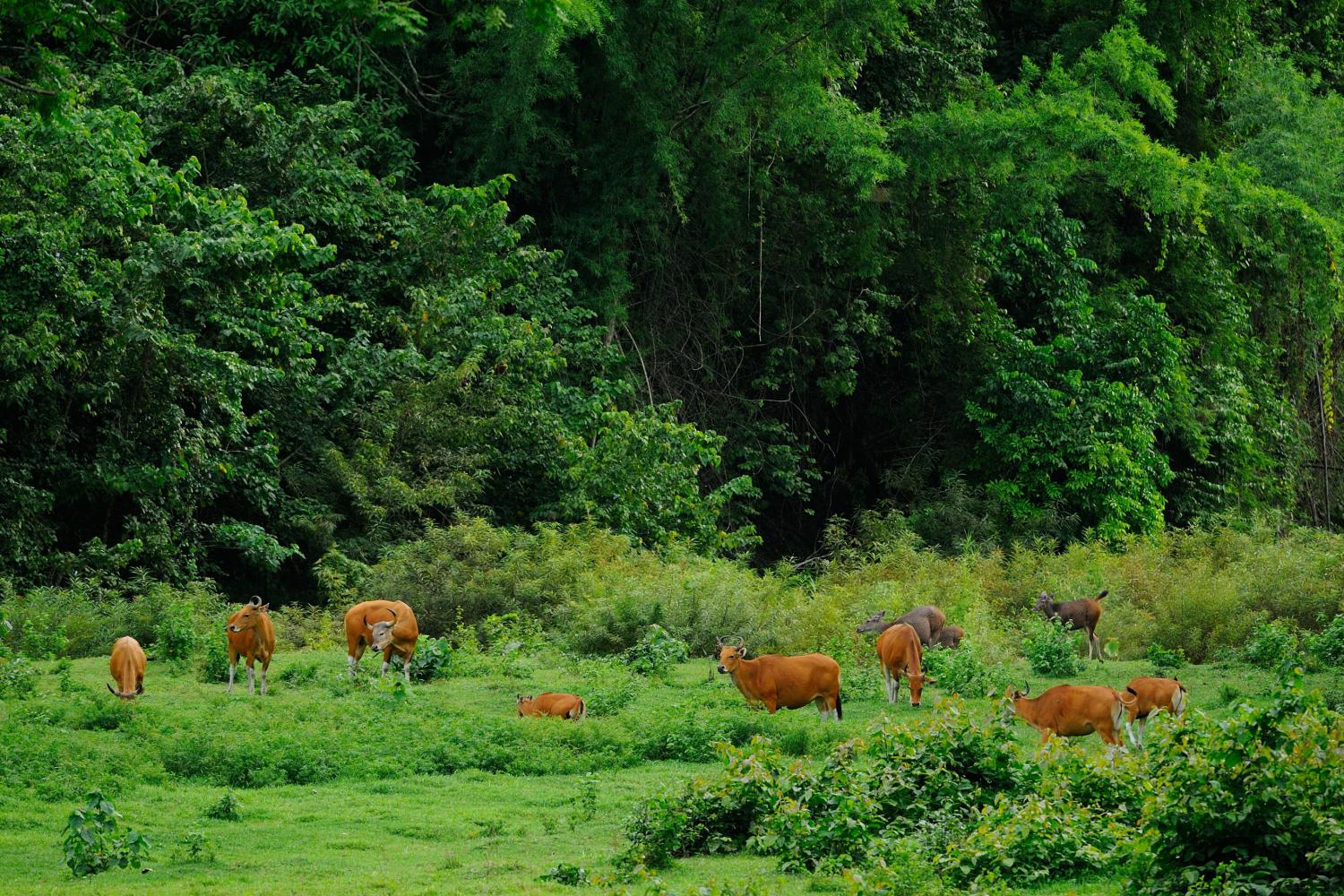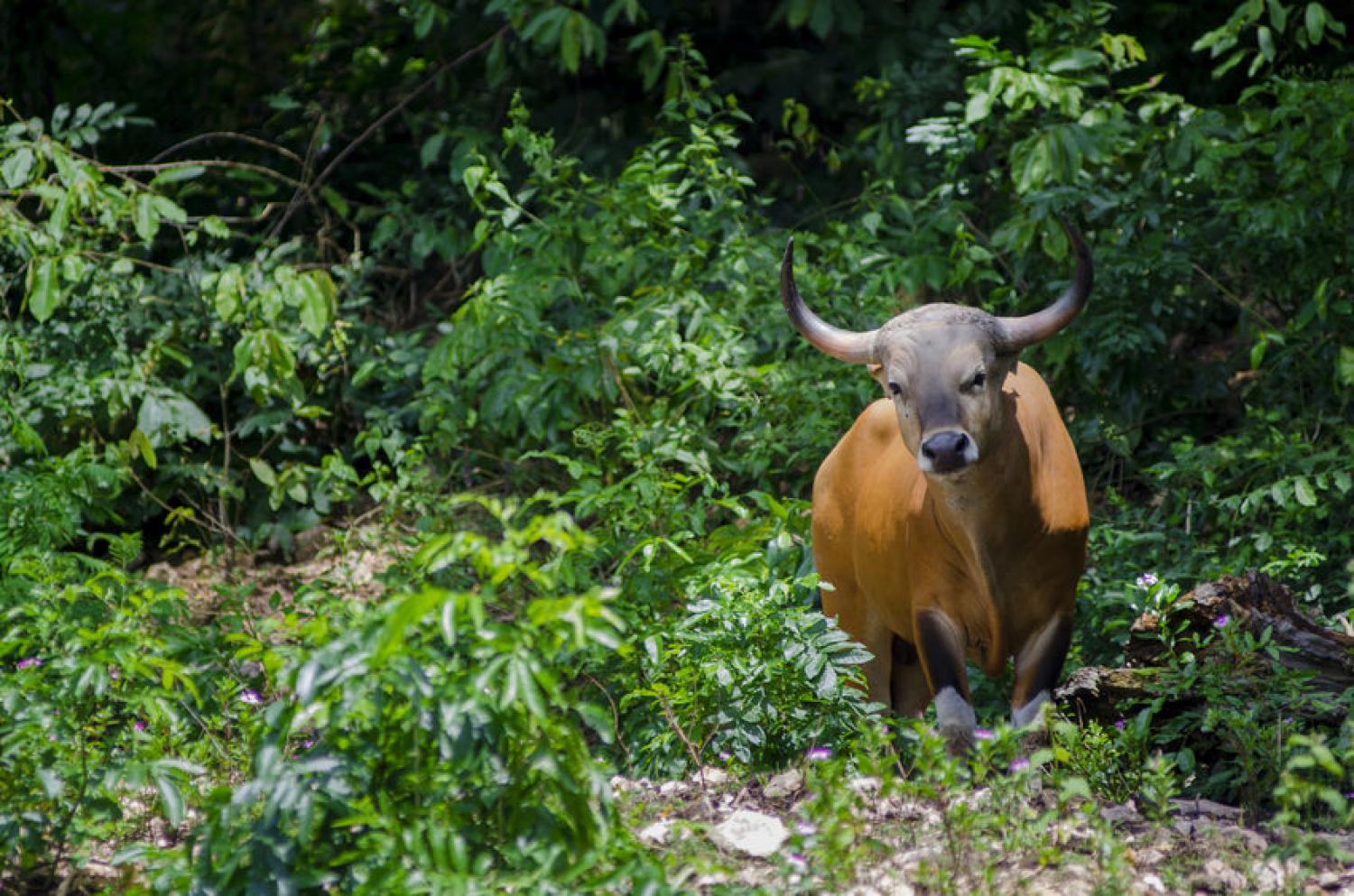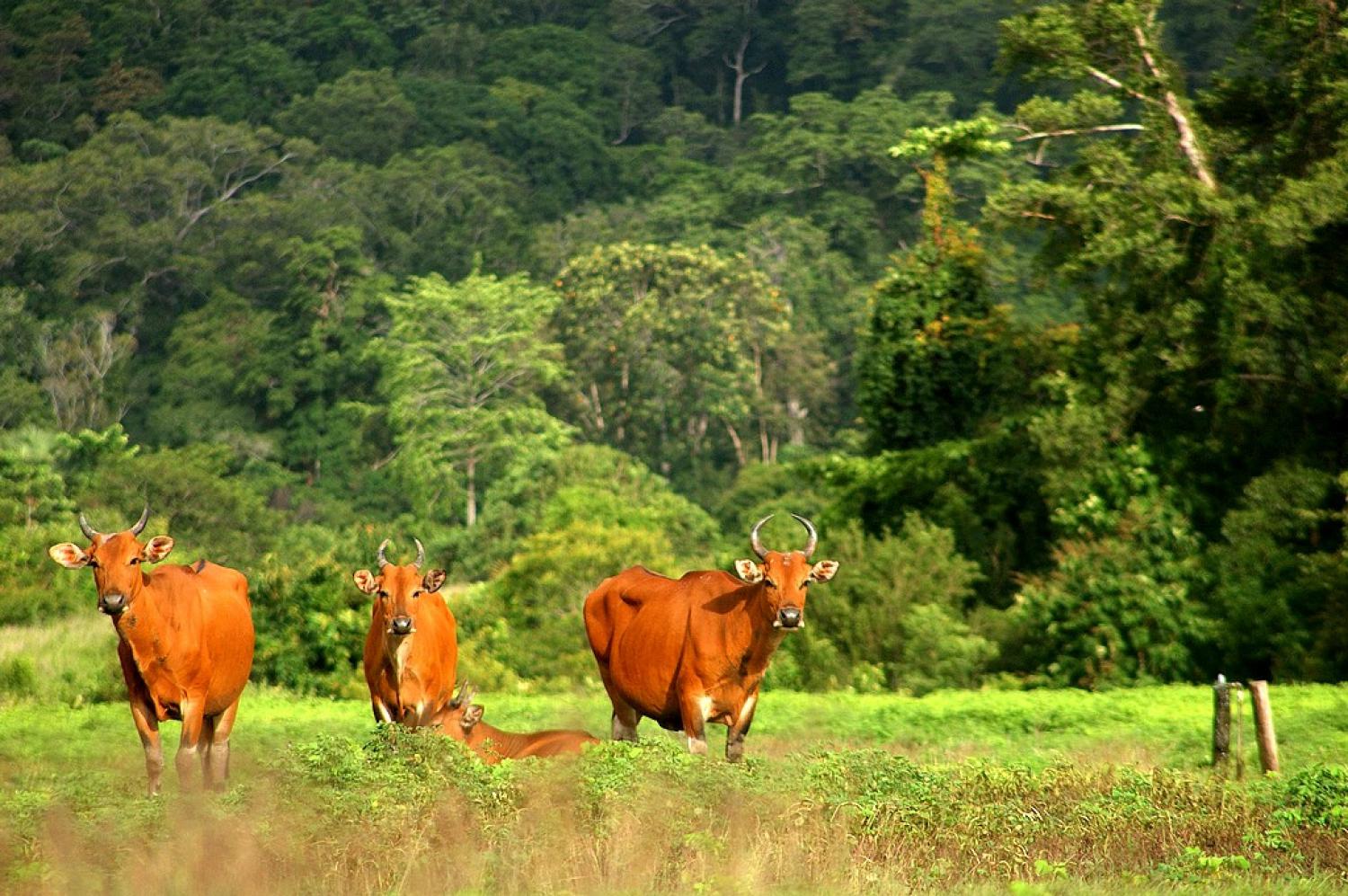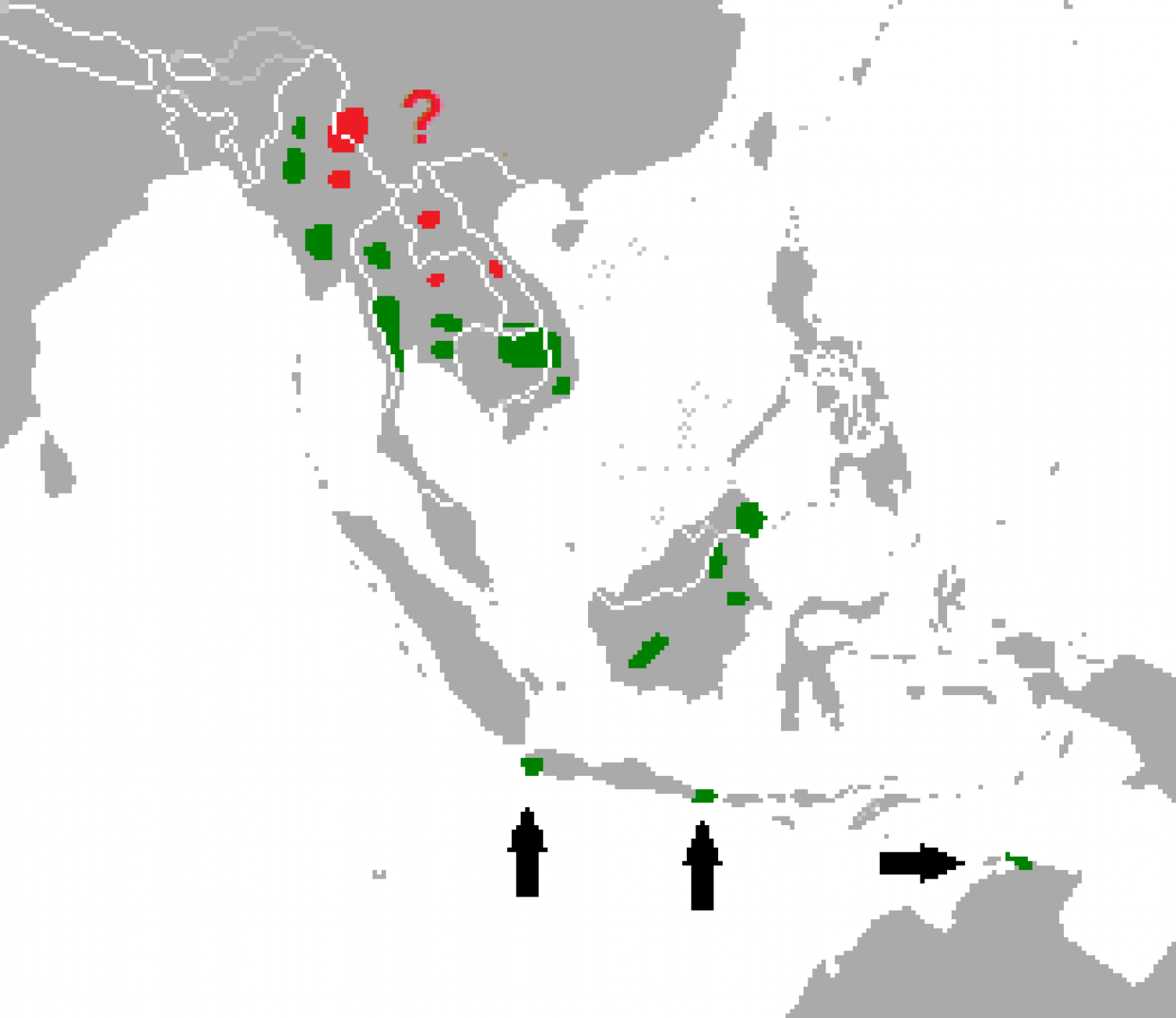Species of Thailand
Banteng
Bos javanicus
Eduard Joseph d'Alton, 1823
In Thai: วัวแดง
The banteng, Bos javanicus, also known as tembadau, is a species of wild cattle found in Southeast Asia.
Banteng have been domesticated in several places in Southeast Asia, and there are around 1.5 million domestic banteng, which are called Bali cattle. These animals are used as working animals and for their meat. Banteng have also been introduced to Northern Australia, where they have established stable feral populations.
Characteristics
The banteng is similar in size to domestic cattle, measuring 1.55 to 1.65 m ftin tall at the shoulder and 2.45 - 3.5 m ftin in total length, including a 60 cm tail. Body weight can range from 400 to 900 kg. It exhibits sexual dimorphism, allowing the sexes to be readily distinguished by colour and size. In mature males, the short-haired coat is blue-black or dark chestnut in colour, while in females and young it is chestnut with a dark dorsal stripe. Both males and females have white stockings on their lower legs, a white rump, a white muzzle, and white spots above the eyes. The build is similar to that of domestic cattle, but with a comparatively slender neck and small head, and a ridge on the back above the shoulders. The horns of females are short and tightly curved, pointing inward at the tips, while those of males arc upwards, growing 60 to 75 cm sigfig=2 long, and being connected by a horn-like bald patch on the forehead.
Behaviour
Banteng live in sparse forest where they feed on grasses, bamboo, fruit, leaves and young branches. The banteng is generally active both night and day, but in places where humans are common they adopt a nocturnal schedule. Banteng tend to gather in herds of two to thirty members.
Status
The wild banteng is considered as endangered by the IUCN. The populations on the Asian mainland have decreased by about 80% in the last decades. The total number of wild bantengs is estimated to about 5, 000-8, 000 animals. No population has more than 500 animals, only a few have more than 50. Reasons for the population decline are reduction of habitat, hunting, hybridisation with domestic cattle and infections with cattle diseases. The most important stronghold for the species is Java with the biggest populations in Ujung Kulon National Park and Baluran National Park. The biggest population on the mainland is found in Huai Kha Khaeng Wildlife Sanctuary in Thailand. Another larger population lives in Kaeng Krachan. Borneo has still a few hundred bantengs, more than a hundred of which occur in Kulamba Wildlife Reserve in Sabah.
Cloning
The banteng is the second endangered species to be successfully cloned, and the first to survive for more than a week (the first was a gaur that died two days after being born). Scientists at Advanced Cell Technology in Worcester, MA, U.S. extracted DNA from banteng cells kept in the San Diego Zoo's "Frozen Zoo" facility, and transferred it into eggs from domestic cattle, a process called somatic cell nuclear transfer. Thirty embryos were created and sent to Trans Ova Genetics, which implanted the fertilized eggs in domestic cattle. Two were carried to term and delivered by Caesarian section. The first was born on April 1, 2003, and the second two days later. The second was euthanized, apparently suffering from large-offspring syndrome, but the first survived and lived for seven years at the San Diego Zoo, where it died in April 2010.
Hybridization program
A hybridization (crossbreeding) program which began in June 2011 made 5 cows pregnant. Genetically, Balinese cows are indeed the offspring of Javanese bulls, but today Balinese cows are smaller in size and weight. To help improve the quality and productivity of new breeds, the Javanese bulls (Bos javanicus) who were transported from the Baluran National Park in Banyuwangi, have been kept under a specialists's care to breed 10 Balinese cows (Bos javanicus f. domestica).
Banteng in Australia
The domesticated form of the banteng was first introduced to Australia in 1849 with the establishment of a British military outpost called Port Essington on the Cobourg Peninsula. Twenty animals were taken to the western Arnhem Land, in present-day Northern Territory, as a source of meat. A year after the outpost’s establishment, poor conditions including crop failure and tropical disease led to its abandonment. On the departure of British troops, the banteng were released from their grazing pastures and allowed to form a feral population. By the 1960s, researchers realized that a population of about 1, 500 individuals had developed in the tropical forests of the Cobourg Peninsula.
Since their introduction in 1849, the population has not strayed far from its initial point of domesticated life; all currently live within the Garig Gunak Barlu National Park. As of 2007, the initial population had grown from only 20 in 1849 to 8, 000-10, 000 and is used exclusively for sport hunting and by Aboriginal subsistence hunters.
As of February 2005, the banteng population of the Cobourg Peninsula is 10, 000 head, making the population in the Northern Territory the largest in the world. Before the study by Charles Darwin University, it was believed that only 5, 000 pure-strain banteng survived worldwide. In their native range, the largest herd numbers less than 500.
Physiology and reproduction in Australia
The banteng of the Cobourg Peninsula have developed slightly different life processes than their domesticated counterparts. Growth over lifetime is sexually dimorphic; males grow faster and are larger than females. Furthermore, females reach maximum body mass in three to four years, while males take five to six. Males achieve sexual maturity at three to four years, and females at two to four years. Fecundity declines in older females. Breeding is seasonal: maximum mating occurs during October and November, and most births take place in the winter months of June to August. Calf mortality is high in the first six months of life, and declines quickly thereafter with increasing body size. When compared with domestic populations, it was found that increased food in captive conditions led to higher fecundity, earlier maturation, and lower juvenile mortality.
Environmental impact in Australia
Despite being a non-native species, the feral Australian banteng has adapted to interact positively with native bird populations. Studies have shown that mutual relationships have developed involving the removal of ectoparasites residing on the bovid body by the Torresian crow (Corvus orru). This is especially notable because it is the first known relationship where a native bird shares a mutual symbiotic relationship with a non-native wild mammal, and it only needed 150 years to develop.
Within the Garig Gunak Barlu National Park, where practically all Australian banteng reside, there has been limited damage due to overgrazing. They are found primarily within the monsoon forests, but cause little damage, especially when compared with feral pigs. Within the forest, population density was found to be around 70 per square kilometer, close to that on their initial introduction 140 years ago, perhaps because of the possibility that their habitat is a uniquely suitable mosaic of grassland and monsoon forest. Another likely reason for their limited dispersal is the presence of fences along the southern end of the peninsula, installed to manage movement of other feral species like the water buffalo. Interaction with the habitat is also unclear regarding monsoonal forest succession into grasslands. Within the Garig Gunak Barlu National Park researchers noticed that monsoonal seedlings were encroaching into previously well established grasslands. It is possible that grazing by banteng minimises potential dry grass build-up, thus limiting encroachment of seasonal fires (and hence post-fire grassland) into monsoonal forest areas and that this may be assisting the spread and germination of monsoonal forest seeds. However this possibility was not firmly concluded by the study.
Conservation value in Australia
Since Australian banteng are considered an invasive non-native species, some environmental scientists believe that complete removal of the population would allow previously occupied habitat to revert to its pre-1849 state and allow native species to return. However, this is not universally supported, both because of the socio-economic niche the banteng has occupied, and because of its role in helping to recover endangered wild populations in Asia.
Small populations in northern Australia are heavily relied on as a source of income for sport hunting, as well as by aboriginal peoples. Studies revealed that as much as A$200, 000 can be made annually from hunting, without damaging population stability.
The current population of banteng in Australia has become the center of debate due to its endangered status in its native Asia. Wild banteng are extremely rare in Asia due to loss of suitable habitat. Domesticated banteng are regularly used in Southeast Asia as grazers in agricultural settings, but these domestic bantengs have varying degrees of introgression from other domesticated Bos species. Australian bantengs are derived from the domesticated form and not from the rare wild form, but genetic studies have revealed that Australian bantengs are identical to the Asian Bos javanicus and therefore not crossed with other species. This is what places the Australian population in a different conservation category than its domesticated conspecific in Southeast Asia.
Since a small founder event occurred with only approximately 20 previously domesticated individuals, a genetic bottleneck has inevitably occurred, causing all current individuals in Australia to lack genetic diversity as a result of inbreeding. This was proven using microsatellites, 12 in all, to determine that their inbreeding coefficient was high, F=0.58. These findings were much higher than the endangered artiodactyl populations in Southeast Asia. Despite the limited genetic pool of this population, conservationists hope that at-risk populations can be preserved. Some have proposed that a deliberate introduction of the endangered populations to the stable but non-native Australian variety would enable viable conservation, even though it is not known how it would affect Northern Territory grazing ranges.
This article uses material from Wikipedia released under the Creative Commons Attribution-Share-Alike Licence 3.0. Eventual photos shown in this page may or may not be from Wikipedia, please see the license details for photos in photo by-lines.
Site notes
The best place to see this species in Thailand is Huai Kha Khaeng Wildlife Santuary, another place to see this species in smaller numbers is Kui Buri National Park.
Scientific classification
- Kingdom
- Animalia
- Phylum
- Chordata
- Class
- Mammalia
- Order
- Artiodactyla
- Family
- Bovidae
- Genus
- Bos
- Species
- Bos javanicus
Common names
- German:
- Banteng
- Sunda-Ochse
- English:
- Banteng
- Bali cattle
- Domestic banteng
- Tembadau
- Spanish: Banteng
- French:
- Banteng
- Tembadau
- Italian:
- Banteng
- Bue della Sonda
- Dutch: Banteng
- Russian: Бантенг
- Swedish: Banteng
- Thai:
- วัวแดง
- วัวดำ
- วัวบา
- วัวเพลาะ
- วัวแดงพม่า
Subspecies
Bos javanicus birmanicus, Anne Ropiquet et al., 2008
Common name: Burma banteng
Range: Myanmar, Thailand, Cambodia, Laos and Vietnam, these males and females are usually buff, but in Cambodia, 20% of the bulls are blackish, and on the Malayan Peninsula in Thailand, most of the bulls are black. This subspecies is recognised by the IUCN but not by Mammal Species of the World, 3rd edition.
Bos javanicus javanicus, Eduard Joseph d'Alton, 1823
Common name: Java banteng
Range: Java and Bali, the males are black and females are buff.
Bos javanicus lowi, Richard Lydekker, 1912
Common name: Borneo banteng
Range: Borneo, they are smaller than Java banteng and the horns are steeper; bulls are chocolate-brown.
Synonyms
- Bos lowi, Richard Lydekker (1912)
- Bos birmanicus, Richard Lydekker (1898)
Conservation status

Critically Endangered (IUCN3.1)
Photos
Please help us review our species pages if wrong photos are used or any other details in the page is wrong. We can be reached via our contact us page.
Range Map
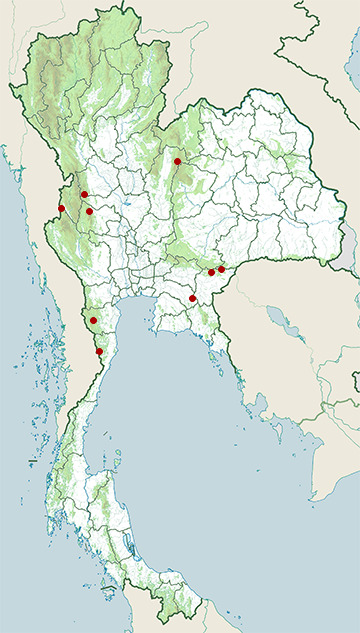
- Huai Kha Khaeng Wildlife Sanctuary
- Kaeng Krachan National Park
- Khao Ang Rue Nai Wildlife Sanctuary
- Kui Buri National Park
- Mae Wong National Park
- Nam Nao National Park
- Pang Sida National Park
- Ta Phraya National Park
- Thung Yai Naresuan Wildlife Sanctuary
